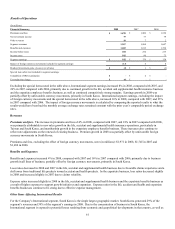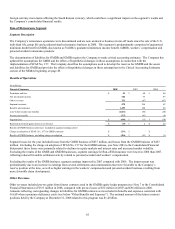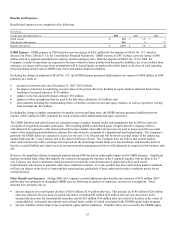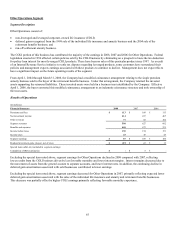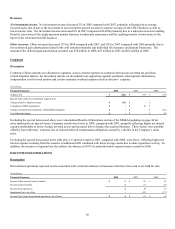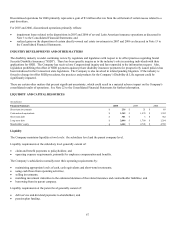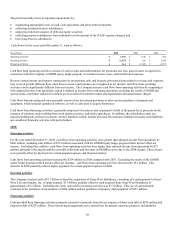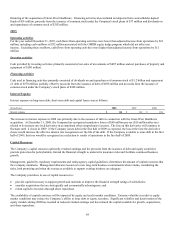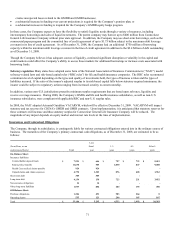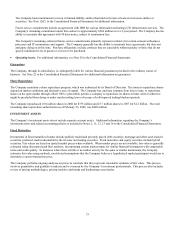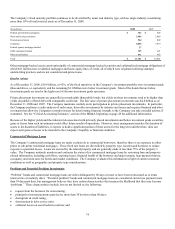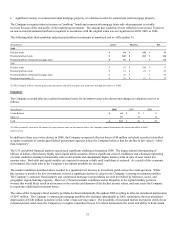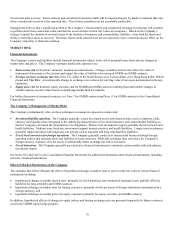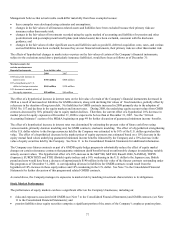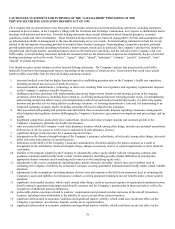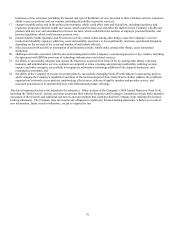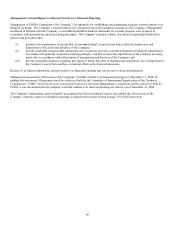Cigna 2008 Annual Report Download - page 91
Download and view the complete annual report
Please find page 91 of the 2008 Cigna annual report below. You can navigate through the pages in the report by either clicking on the pages listed below, or by using the keyword search tool below to find specific information within the annual report.
71
creates unexpected losses related to the GMDB and GMIB businesses;
• a substantial increase in funding over current projections is required for the Company’s pension plan; or
• a substantial increase in funding is required for the Company’s GMDB equity hedge program.
In those cases, the Company expects to have the flexibility to satisfy liquidity needs through a variety of measures, including
intercompany borrowings and sales of liquid investments. The parent company may borrow up to $400 million from Connecticut
General Life Insurance Company without prior state approval. In addition, the Company may use short-term borrowings, such as the
commercial paper program and the committed line of credit agreement of up to $1.75 billion subject to the maximum debt leverage
covenant in its line of credit agreement. As of December 31, 2008, the Company had an additional $750 million of borrowing
capacity within the maximum debt leverage covenant in the line of credit agreement in addition to the $2.4 billion of debt outstanding
as of December 31, 2008.
Though the Company believes it has adequate sources of liquidity, continued significant disruption or volatility in the capital and
credit markets could affect the Company’s ability to access those markets for additional borrowings or increase costs associated with
borrowing funds.
Solvency regulation Many states have adopted some form of the National Association of Insurance Commissioners (“NAIC”) model
solvency-related laws and risk-based capital rules (“RBC rules”) for life and health insurance companies. The RBC rules recommend
a minimum level of capital depending on the types and quality of investments held, the types of business written and the types of
liabilities incurred. If the ratio of the insurer's adjusted surplus to its risk-based capital falls below statutory required minimums, the
insurer could be subject to regulatory actions ranging from increased scrutiny to conservatorship.
In addition, various non-U.S. jurisdictions prescribe minimum surplus requirements that are based upon solvency, liquidity and
reserve coverage measures. During 2008, the Company’s HMOs and life and health insurance subsidiaries, as well as non-U.S.
insurance subsidiaries, were compliant with applicable RBC and non-U.S. surplus rules.
In 2008, the NAIC adopted Actuarial Guideline VACARVM, which will be effective December 31, 2009. VACARVM will impact
statutory and tax reserves for CIGNA's GMDB and GMIB contracts. Upon implementation, it is anticipated that statutory reserves for
these contracts will increase and thus statutory surplus for Connecticut General Life Insurance Company will be reduced. The
magnitude of any impact depends on equity market and interest rate levels at the time of implementation.
Guarantees and Contractual Obligations
The Company, through its subsidiaries, is contingently liable for various contractual obligations entered into in the ordinary course of
business. The maturities of the Company’s primary contractual cash obligations, as of December 31, 2008, are estimated to be as
follows:
Less
(In millions, on an than 1 1-3 4-5 After 5
undiscounted basis) Total year years years years
On-Balance Sheet:
Insurance liabilities:
Contractholder deposit funds $ 7,591 $ 646 $ 797 $ 733 $ 5,415
Future policy benefits 11,670 505 1,030 847 9,288
Health Care medical claims payable 924 924 - - -
Unpaid claims and claims expenses 4,770 1,303 876 628 1,963
Short-term debt 305 305 - - -
Long-term debt 4,134 138 723 221 3,052
Non-recourse obligations 16 16 - - -
Other long-term liabilities 1,933 886 404 193 450
Off-Balance Sheet: 1
Purchase obligations 1,226 451 503 264 8
Operating leases 535 121 200 107 107
Total $ 33,104 $ 5,295 $ 4,533 $ 2,993 $ 20,283


